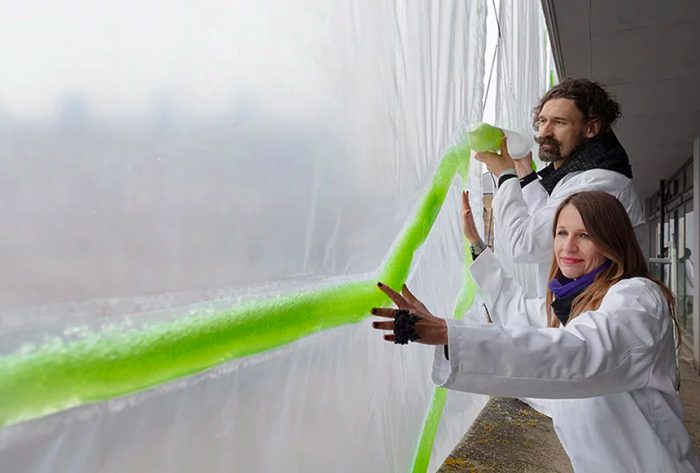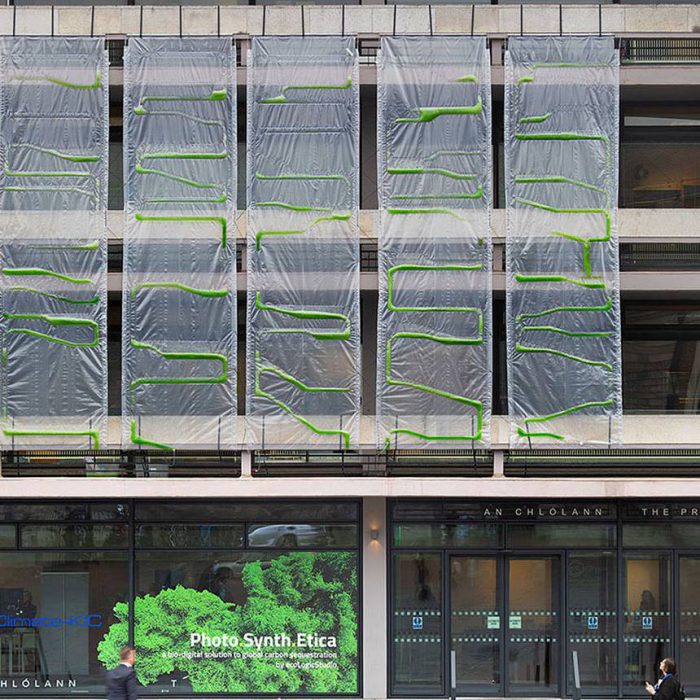In the fight against climate change, there are many approaches being proposed. Most of them are trying to lower the amount of carbon pollution that we put into the air. These solutions include everything from burning less coal, making eco-friendly electric vehicles, and eating less red meat. But what about the carbon that is already up in the atmosphere?
To address that, you need something that can pull the carbon out. And nothing does that like quite like plants. As most of us already understand, when plants breathe they pull carbon dioxide out of the air. As they photosynthesize, they then breathe out oxygen. In other words, more plants in the world = less carbon in the air.
Now the real puzzle is figuring out new ways to make places, like cities, carbon munchers instead of carbon makers. Algae curtains, anyone?
Getting the hang of it

In goes the algae... (NARRO/Photo.Synth.Etica)
You read that right: algae curtains!
A collaborative group called Photo.Synth.Etica has created what they call the AlgaeClad system. Essentially, these are giant plastic curtains with algae flowing through them that are hung from the sides of buildings. As polluted air is pumped upward alongside the curtains, the algae inside munches away the CO2. (Nom nom!) Meanwhile, the process releases fresh oxygen at the top of the curtain.
Once the algae is "spent" (or has stored its maximum amount of CO2), it can be removed and used as material for other products. Then new green algae is pumped into the curtain and the whole process starts again. Sounds great, right?
But is it practical?

As the algae reaches its limit of CO2 intake, it turns an orange colour. (NARRO/Photo.Synth.Etica)
The curtains are made from an extremely durable plastic called EFTE (Ethylene Tetrafluoroehtylene). EFTE is already used as a building material in everything from football stadiums, shopping centres, and the Eden Project—a futuristic village of greenhouse biomes in Cornwall, England. So they should be tough enough to handle whatever nature throws at them.
The curtains are made of the same material as the roof of the Eden Project. (Getty Embed)
And according to its designers, one curtain is able to remove the same amount of CO2 as twenty large trees—about 1 kg (2.2 pounds) a day. That's pretty impressive. And algae is readily available and grows easily.
The drawbacks? For starters, you'd have to convince people that these curtains would be attractive enough to hang from their buildings. (Let's face it, we humans are often all about appearances.) And then there is the question of what leftover algae is really good for. As it turns out, quite a bit. It can be used as a biofuel, and it's also a potential replacement ingredient in the production of numerous household items.
The AlgaeClad system is designed to be added to existing buildings, though the folks at Photo.Synth.Etica are dreaming even bigger. They hope that their algae curtains can begin to be considered in the overall design of new buildings. Really takes the idea of green buildings to the next level, right?
 These AlgaeClad curtains are mighty carbon munchers. (NARRO/Photo.Synth.Etica)
These AlgaeClad curtains are mighty carbon munchers. (NARRO/Photo.Synth.Etica)









